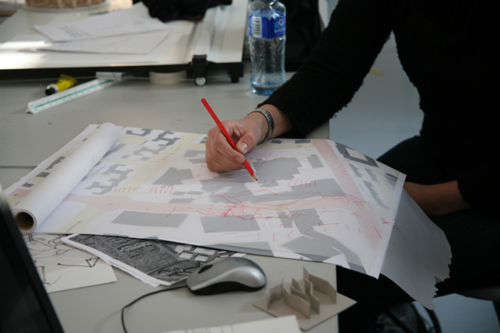What is it like – day to day – to be a student of architecture at Queen’s? Here are three perspectives on the student life at QUB, from three different levels in the School of Planning, Architecture and Civil Engineering.
Undergraduate (BSc Architecture, RIBA Pt. I)
Rita, 18 is from London:
Coming into the Architecture course from having studied Art, English and Math at A level was definitely a challenging transition. I found that having art and maths were a help, but they were not essential. A typical day for me, now I have grown accustomed to what is required, would be in the studio for about 9 and work until about 1 when a group of us would go and get lunch and chill for a bit. We would then continue working, helping each other with ideas and work. It’s good to be in the studio as you’re surrounded by inspiration and it is a good atmosphere to work in.
We also have lectures and tutorials throughout the week which tie in with our studio work. As we have all spent so much time with each other in the studio you find that you become very close and we tend to socialise together outside the studio.
Taught Postgraduate (MArch, RIBA Pt. II)
Petrina:
When trying to describe how I spend my day as an architecture student, a bit like what I have discovered about the method of design, it does not follow a linear process. Some days I may make discoveries therefore changing my path. If such a discovery did not work out as I had expected, its ok, I can rule that out and return to where I was before, it is another lesson learned; exploration is always beneficial. However to give an idea what it is like as a fifth year student I may give a rough outline of what I may be on my mind during the day. Up early and out to the studio, tutorials at 10am. To differentiate from tutorials in undergraduate it has evolved from getting yes/no answers from the tutor to them asking me “What do you think?” It can be quite frustrating at first however it is all part of becoming one’s own person and being able to make decisions based upon research and experimentation. I am glad I enjoy making models as it is highly promoted in Queen’s and it is through this we are encouraged to experiment, as well as reading, fortunately another task I take pleasure in doing. After being encouraged to look at some text in a tutorial, I find it in the library and may discover it also has influences relevant to my dissertation, which is always at the back of one’s mind throughout fifth year. The design project and the dissertation, as I see it, can be seen as overlapping, having an impact on each other.
Through the method of teaching I have found it has become even more self directed in post graduate. Everyone’s daily strategies can differ, because they are best suited to that person. This is found through the encouragement of tutors for students to find their own path, giving integrity to their work
Research Postgraduate (PhD)
James, 27, is from Cambridge and is in the second year of PhD studies at SPACE:
Studying towards a PhD (Doctor of Philosophy) effectively means going where no-one else has gone before: researching and writing an original and unexplored piece of research which you present in a thesis. There are no regular classes as such, so my diary can look deceptively empty. It is entirely up to me to structure my week and my day and to ensure I meet the expectations of my supervisors, who I normally meet formally once a month for an hour or two to discuss progress. This is fantastically liberating – and allows me to work around family and home commitments, but also puts a great deal of pressure on me to be organised and self-motivated.
Many PhD students talk about the loneliness of this kind of work – and it can be isolating, but the solution is to reach out to your colleagues and work with them on seminars and programmes of mutual interest. I will normally try to structure my day as if my PhD were a job: aiming for seven to eight hours work every day, with a mixture of reading journals and books with planning or executing research. Sometimes this can bleed into the evenings and weekends, but I usually get more done at home anyway. I’m not based in the lab, although many of my colleagues in engineering are, so I enjoy their company in the communal office we share on campus. Alternatively I work from home or in our new university library overlooking the Botanic Gardens.

